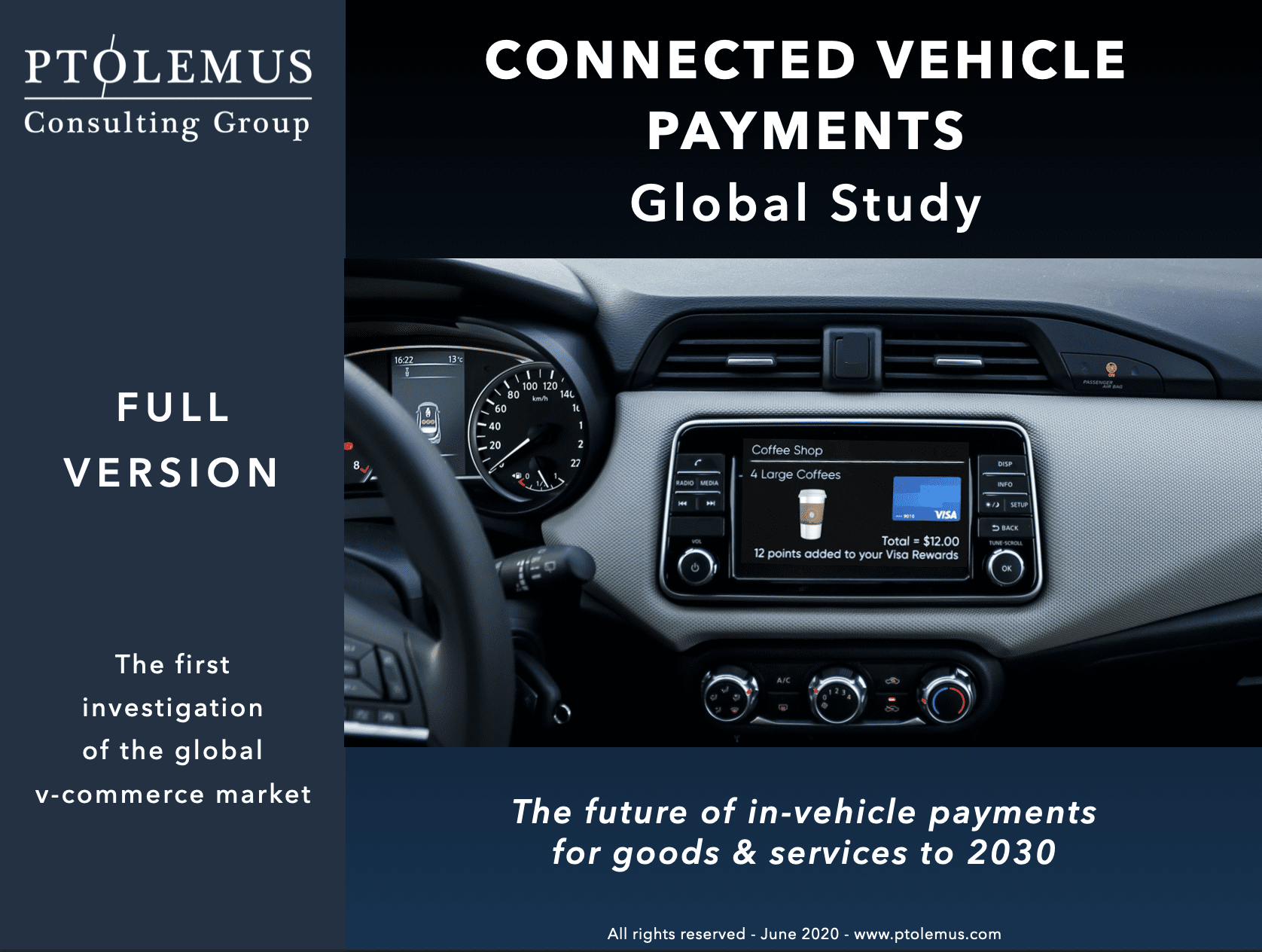The Connected Vehicle Payments Global Study

The Connected Vehicle Payments Global Study
1495€
The first in-depth assessment and forecast of the connected vehicle payments (v-commerce) market

Our Connected Vehicle Payments Global Study, is the first in-depth report to analyse how vehicle commerce (or “v-commerce”) will open up new revenue opportunities, answers these questions, and brings timely insights into a global market that is set to grow to a whopping €537 billion by 2030.
Did you know that during the “COVID lockdown” we have seen the increase in use of cashless payment alternatives? From toll booths to drive-thru’s the switch to a cashless society, in all countries impacted by COVID-19, has been significant, with cash withdrawals collapsing by 60-90%.
This presents an enormous opportunity for service providers and OEMs alike, as OEMs’ and service providers’ connecting payment strategies build momentum.
The question is which areas are growing the fastest? Which are poised to dominate the market? Which will remain niche?
The Connected Vehicle Payments Global Study is the first in-depth report to analyse how electronic payment transactions will open up new revenue opportunities for OEMs, services and payment providers across the value chain, and 10 industry verticals.
The 282-page study, contains:
- An assessment of the connected car payments market today and the benefits it generates
- An investigation of the tech giants’ increasing presence in the sphere, such as with Amazon’s Alexa and Amazon Pay, Google’s Google Assistant and Google Pay and Alibaba’s Tmall Genie (天猫精灵) and AliPay (支付宝)
- An appraisal of the significance of connected car voice assistants to winning in the market
- An analysis of 17 OEM strategies worldwide, including in-depth case studies of connected vehicle payments implementations by OEMs, including:
-
- Volkswagen
- Honda
- BMW
- Hyundai
- GM
- Tesla
- SAIC Motor
- 32 in-depth case studies of connected car payments programmes (such as Honda Dream Drive)
- Case studies involving 6 platform providers (including SiriusXM and Xevo) and 6 aftermarket solution providers (including Telepass and EasyPark)
- An exploration of the macro and technological requirements that will support the adoption of connected car commerce
- A discussion of the pros and cons of different consumer-facing in-vehicle payment interfaces
- An appraisal of the significance of connected car voice assistants to winning the market, with enablers such as Amazon, Google, Alibaba and Cerence
- A glimpse at payment technologies, system integrity and security of connected car transactions, involving payment providers such as Visa, Mastercard and PayPal
- A look at geographic and cultural differences comparing US, Europe and Asia Pacific
- An evaluation of the future direction of connected vehicle payments
- A bottom-up forecast of the global connected car payment market for 2030, covering 5 regions with specific figures for 18 markets, and taking into account the impact of COVID-19
- Coverage of 10 vertical markets, including:
- Fuelling;
- Electric vehicle charging;
- Road usage charging;
- Parking;
- Ferry & bridge access;
- Food & beverage;
- Grocery;
- Entertainment;
- Roadside assistance, and;
- Repair & maintenance
The Connected Vehicle Payments Global Study provides you with an unparalleled understanding of:
- The revenue potential for transactions driven by and conducted within connected cars;
- The business model for OEMs;
- Which vertical markets have the best revenue potential;
- What connected vehicle payment approach is the best fit for your business, and;
- Which OEMs are the most - and least - open to connected car payment partnerships
The report enables you to:
- Save time planning your connected vehicle payments strategy, by understanding the strategic considerations of a connected vehicle payments strategy. This is supported by the 18 key takeaways that a connected vehicle payment player must fully grasp to be successful
- Better assess the tech giants’ positions, with the report's evaluation of their strategies across the board, including a illustrative chart that details Amazon, Google, Alibaba and other tech giants’ existing global partnerships with OEMs
- Scope out potential partners, through reading our case studies of the OEMs, platform providers and aftermarket solution providers, and understanding their current partnership strategy
- Benchmark your current performance versus your competitors, via our case studies and assessment of the 17 leading OEMs' connected vehicle payments programmes
- Increase your ROI by targeting the right markets relating to your strategy, with the report's insight into what regulations are currently being discussed, if they will be implemented and how they will shape the future of connected vehicle payments around the world
- Maximise the potential revenue opportunity for your connected vehicle payments strategy, by using our 2030 forecasts to understand the revenue opportunities for the future connected vehicle payment industry


The report features:
- 282 pages of analysis on the current and future volume and value of the global connected car payment industry
- Analysis of the connected car payment industry across 18 markets
- The identification of which user experience, interface and payment features will contribute the most to success
- Conclusions that detail where the major revenue opportunities will be across 10 industry verticals, including:
- Fuelling
- Parking
- Food & beverage
- Repair & maintenance
- Specific case studies detailing how 17 of the world's major vehicle OEMs have developed or are working on integrating connected car payment programmes, including:
- Tesla
- Volkswagen
- Honda
- BMW
- Hyundai
- GM
- Forecasts of the volume and value of the connected vehicle payments industry from 2020 to 2030, taking into account the impact of COVID-19
- Revenues and volumes for each of the 10 vertical markets
- Revenues and volumes for each of the 2 implementation categories:
- Line-fitted technology
- Aftermarket devices

